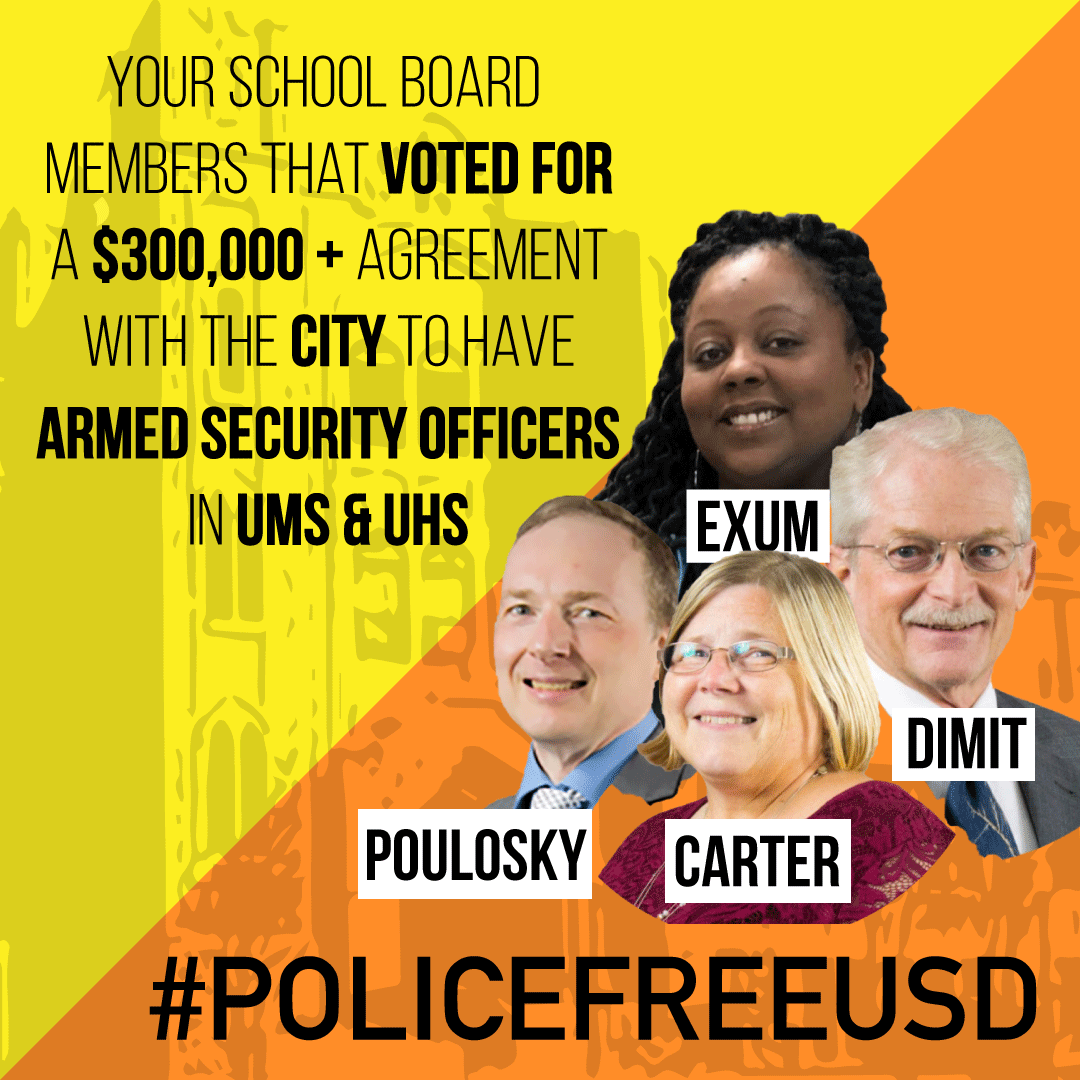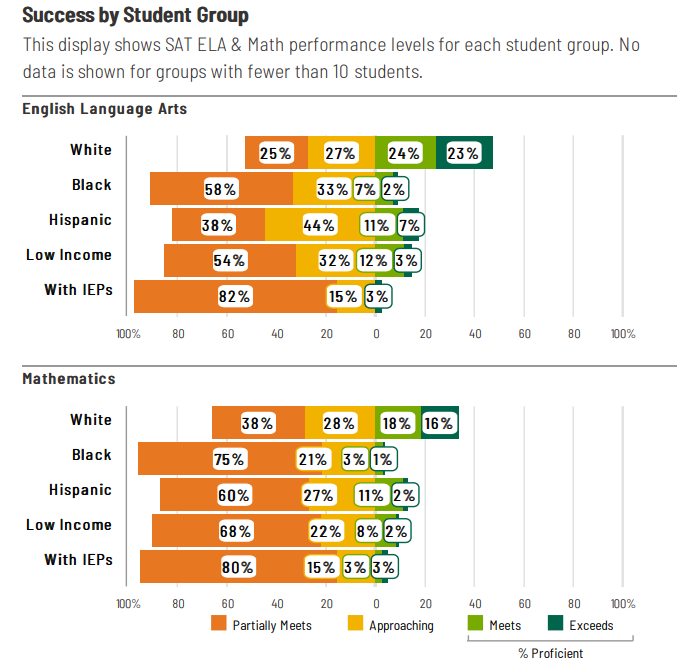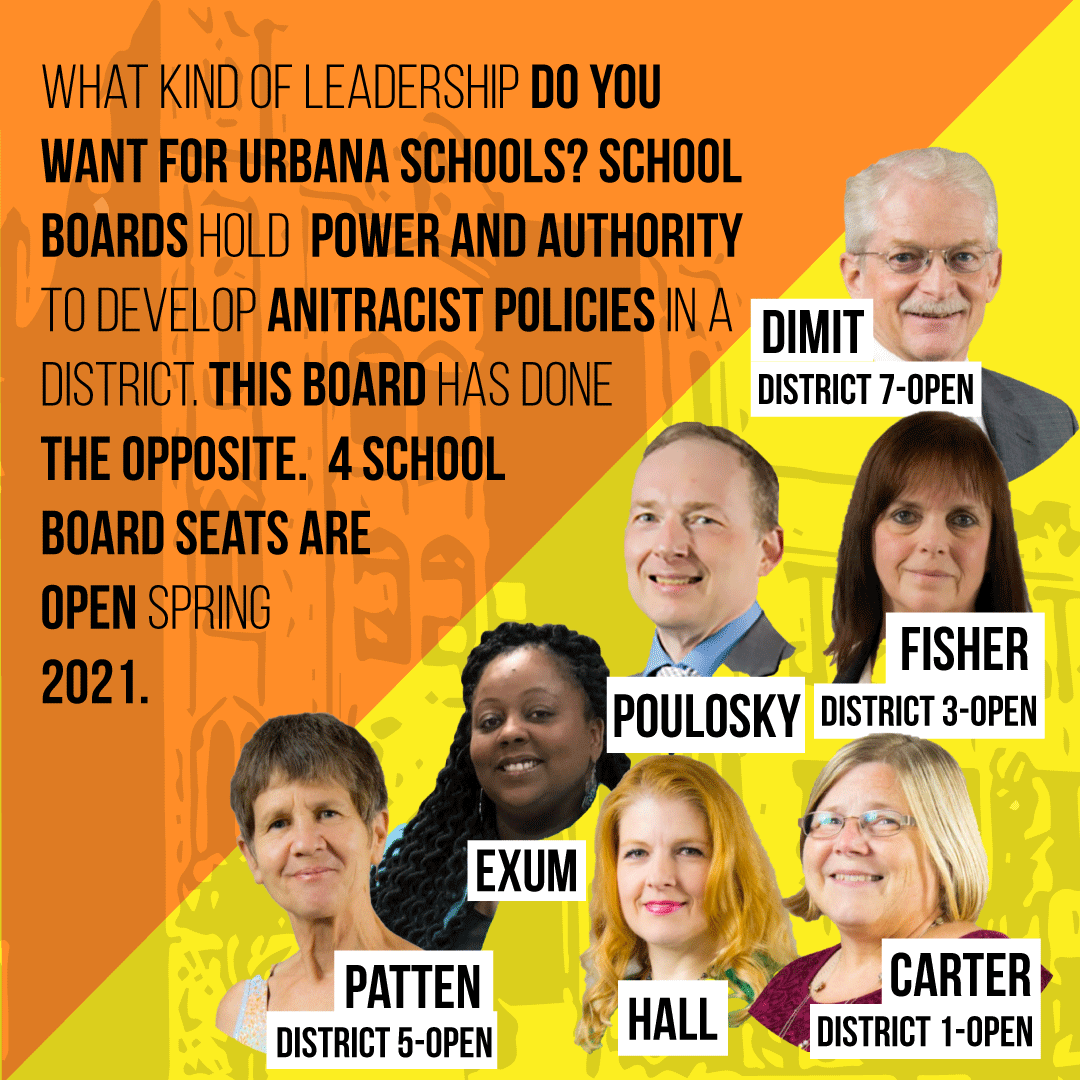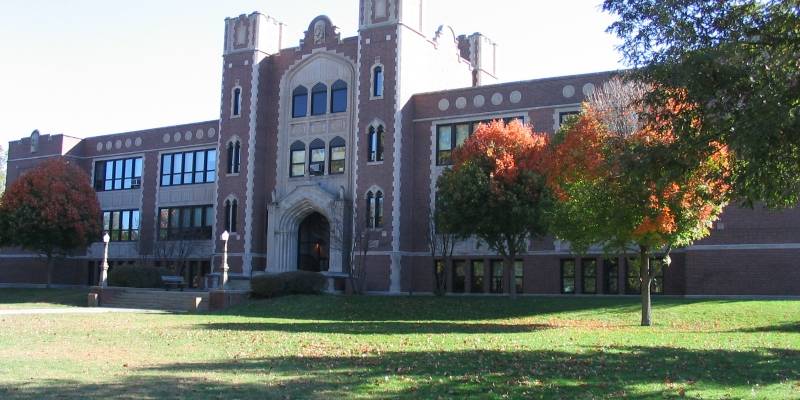On December 17th, 2019, Urbana Board of Education (BOE) signed an intergovernmental agreement to approve funding of two full time armed police officers (SROs) – one at the middle school and one at the high school. The yearly cost to the school district is $321,300.

Image by Ameena Payne and Lara Jobe.
To date, the BOE have not collected any evidence that this presence returns any value for students. According to Section 8B of the contract, the SRO Program is to be formally evaluated two years after being implemented, and then every year thereafter. Further to this, the BOE does not have any planned method to formally evaluate the SRO program’s effectiveness. There are no measures for which they are comparing the effectiveness of the program, nor have there been any indicated plans to disseminate the findings to the public.
The overarching theme of the intergovernmental contract is that the SRO’s are hired by and fall under the direction of the Urbana Police Department (UPD). The cost breakdown, received via a Freedom of Information Act request, reveals that education dollars are not only paying the annual salaries of the two officers ($131,000 per officer), but is paying, annually, for uniforms and guns (one time cost of $7,000+ and a yearly cost of $2,000 per officer), $1,500 to spend on annual professional development per officer, as well as a one-time payment for a vehicle $40,000 plus an annual vehicle maintence fee of per officer of $6K.
This contract does not serve the best interests of the school district, and the costs are not a responsible use of education tax dollars. Additionally, there are no plans for Urbana School District 116 (USD116) to be reimbursed the $275,000 spent, despite the COVID-19 pandemic affecting schools being open.

Image by Ameena Payne and Lara Jobe.
Chronic absenteeism is defined as missing 10% or more of the academic year for any reason, including excused and unexcused absences and suspensions; based on a 180-day school year, that means a student would miss about 18 days per year. Urbana High School’s chronic absenteeism rate is 53%; USD116’s chronic absenteeism is 36%; the state of Illinois sits at 18%. Time spent learning is the single best predictor of positive academic outcomes.
88% of total suspensions in 2019-2020 were Black, Indigenous, People of Color (BIPOC) students. 89% of out-of-school suspensions are BIPOC students. The student body breakdown of USD116 is 37% Black, 31% White, 15% Hispanic, 5% Asian and 1% American Indian; 10% are multi-racial. 54% of total suspension were Black students; 52% of out-of-school suspensions were Black students; this further illustrates that Black students are being suspended at higher rates than their white peers. Education can only fulfill its potential as the great equalizer — a force that can overcome differences in privilege and background — when we work to ensure that students are in school every day and receive the supports they need to learn and thrive.

Image by Ameena Payne and Lara Jobe.
Although federal and state laws require educators to suspend, expel, or refer a student to law enforcement for certain offenses, many educators choose to employ such harsh measures for more trivial matters, such as minor disturbances in the classroom. The connection between academic underachievement and student involvement in the justice system needs to be highlighted and addressed; when students are not engaged in their studies nor graduate from high school and obtain the skills to necessarily to be contributors to their communities, they are more likely to also be involved in the justice system. In Urbana in 2019, there were 252 juvenile arrests — both within and outside of the school setting; 84% of those juvenile arrests were Black youth.
USD116 passed a one-page “Resolution on Commitment to Racial Equity” on 20 November 2018. Yet, when considering the addition of SROs, very little was done to evaluate the presence of armed officers on BIPOC students. There must be a cost/benefit analysis conducted which is shared with the public. Minimizing trauma and harm should be the intent; the program should have been assessed prior to implementation to determine the impacts of two, full-time armed SROs on BIPOC students.

Image by Ameena Payne and Lara Jobe.
In USD116, only 4% of Black and 13% of Hispanic Students “meet or exceed” Mathematics performance levels Yet, 34% of white students “meet or exceed” Mathematics performance levels.

For more information, visit IllinoisReportCard.com.

Image by Ameena Payne and Lara Jobe.
What educational values and beliefs underpin a decision to have SROs in our schools?
Many in education feel the pressure from outside, or above, to implement policy and react in a knee-jerk way. To relieve the pressure, they do what they are told or use anecdotal to support and introduce policy without asking why they should. They pay lip service to the policy; the words are spoken, the paperwork is completed, the policies are written. It all “looks good”, and the words are spoken in meetings. And so, we revolve on a merry-go-round of policies and words paying lip-service to the intended improvement, but within the walls of the school and classroom, little changes.
Policing was never meant to solve all problems.
SROs do not have specialized training in adolescent or childhood development. They are not mental health experts, social workers with licensed degrees, psychologists, trauma-informed educators, or school counselors. SROs are not educators. To be clear, SROs are career law enforcement officers, with arresting authority, and a license to carry a weapon (paid for with education dollars). Police officers patrol school hallways just like they do city streets. There are better, safer, and cheaper alternatives.
The BOE must refocus on the students and their needs, not fund armed police in Urbana schools. They must end the Intergovernmental agreement with the Urbana Police Department and remove SROs from Urbana’s public schools. Send Public Input Public to the Board of Education prior to their 20200-21 budget decision which is being made mid-September: publiccomment@usd116.org .
Additionally, there are several Urbana BOE seats open for election this spring — Districts 1, 3, 5 and 7.

Image by Ameena Payne and Lara Jobe.








